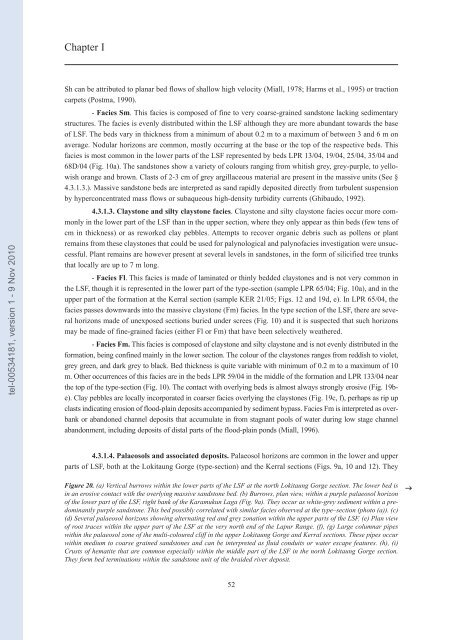Etude stratigraphique, pétrographique et diagénétique des grès d ...
Etude stratigraphique, pétrographique et diagénétique des grès d ...
Etude stratigraphique, pétrographique et diagénétique des grès d ...
Create successful ePaper yourself
Turn your PDF publications into a flip-book with our unique Google optimized e-Paper software.
tel-00534181, version 1 - 9 Nov 2010<br />
Chapter I<br />
Sh can be attributed to planar bed flows of shallow high velocity (Miall, 1978; Harms <strong>et</strong> al., 1995) or traction<br />
carp<strong>et</strong>s (Postma, 1990).<br />
- Facies Sm. This facies is composed of fine to very coarse-grained sandstone lacking sedimentary<br />
structures. The facies is evenly distributed within the LSF although they are more abundant towards the base<br />
of LSF. The beds vary in thickness from a minimum of about 0.2 m to a maximum of b<strong>et</strong>ween 3 and 6 m on<br />
average. Nodular horizons are common, mostly occurring at the base or the top of the respective beds. This<br />
facies is most common in the lower parts of the LSF represented by beds LPR 13/04, 19/04, 25/04, 35/04 and<br />
68D/04 (Fig. 10a). The sandstones show a vari<strong>et</strong>y of colours ranging from whitish grey, grey-purple, to yellowish<br />
orange and brown. Clasts of 2-3 cm of grey argillaceous material are present in the massive units (See §<br />
4.3.1.3.). Massive sandstone beds are interpr<strong>et</strong>ed as sand rapidly deposited directly from turbulent suspension<br />
by hyperconcentrated mass flows or subaqueous high-density turbidity currents (Ghibaudo, 1992).<br />
4.3.1.3. Claystone and silty claystone facies. Claystone and silty claystone facies occur more commonly<br />
in the lower part of the LSF than in the upper section, where they only appear as thin beds (few tens of<br />
cm in thickness) or as reworked clay pebbles. Attempts to recover organic debris such as pollens or plant<br />
remains from these claystones that could be used for palynological and palynofacies investigation were unsuccessful.<br />
Plant remains are however present at several levels in sandstones, in the form of silicified tree trunks<br />
that locally are up to 7 m long.<br />
- Facies Fl. This facies is made of laminated or thinly bedded claystones and is not very common in<br />
the LSF, though it is represented in the lower part of the type-section (sample LPR 65/04; Fig. 10a), and in the<br />
upper part of the formation at the Kerral section (sample KER 21/05; Figs. 12 and 19d, e). In LPR 65/04, the<br />
facies passes downwards into the massive claystone (Fm) facies. In the type section of the LSF, there are several<br />
horizons made of unexposed sections buried under screes (Fig. 10) and it is suspected that such horizons<br />
may be made of fine-grained facies (either Fl or Fm) that have been selectively weathered.<br />
- Facies Fm. This facies is composed of claystone and silty claystone and is not evenly distributed in the<br />
formation, being confined mainly in the lower section. The colour of the claystones ranges from reddish to viol<strong>et</strong>,<br />
grey green, and dark grey to black. Bed thickness is quite variable with minimum of 0.2 m to a maximum of 10<br />
m. Other occurrences of this facies are in the beds LPR 59/04 in the middle of the formation and LPR 133/04 near<br />
the top of the type-section (Fig. 10). The contact with overlying beds is almost always strongly erosive (Fig. 19be).<br />
Clay pebbles are locally incorporated in coarser facies overlying the claystones (Fig. 19c, f), perhaps as rip up<br />
clasts indicating erosion of flood-plain deposits accompanied by sediment bypass. Facies Fm is interpr<strong>et</strong>ed as overbank<br />
or abandoned channel deposits that accumulate in from stagnant pools of water during low stage channel<br />
abandonment, including deposits of distal parts of the flood-plain ponds (Miall, 1996).<br />
4.3.1.4. Palaeosols and associated deposits. Palaeosol horizons are common in the lower and upper<br />
parts of LSF, both at the Lokitaung Gorge (type-section) and the Kerral sections (Figs. 9a, 10 and 12). They<br />
Figure 20. (a) Vertical burrows within the lower parts of the LSF at the north Lokitaung Gorge section. The lower bed is<br />
in an erosive contact with the overlying massive sandstone bed. (b) Burrows, plan view, within a purple palaeosol horizon<br />
of the lower part of the LSF, right bank of the Karamukun Laga (Fig. 9a). They occur as white-grey sediment within a predominantly<br />
purple sandstone. This bed possibly correlated with similar facies observed at the type–section (photo (a)). (c)<br />
(d) Several palaeosol horizons showing alternating red and grey zonation within the upper parts of the LSF. (e) Plan view<br />
of root traces within the upper part of the LSF at the very north end of the Lapur Range. (f), (g) Large columnar pipes<br />
within the palaeosol zone of the multi-coloured cliff in the upper Lokitaung Gorge and Kerral sections. These pipes occur<br />
within medium to coarse grained sandstones and can be interpr<strong>et</strong>ed as fluid conduits or water escape features. (h), (i)<br />
Crusts of hematite that are common especially within the middle part of the LSF in the north Lokitaung Gorge section.<br />
They form bed terminations within the sandstone unit of the braided river deposit.<br />
52<br />
�

















